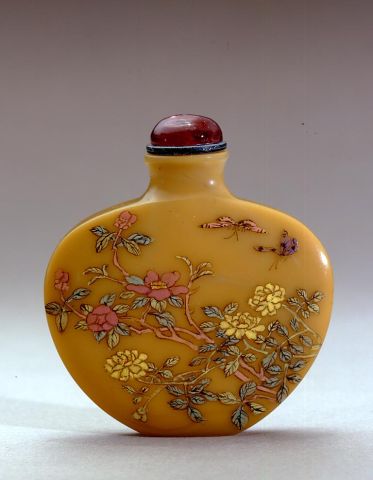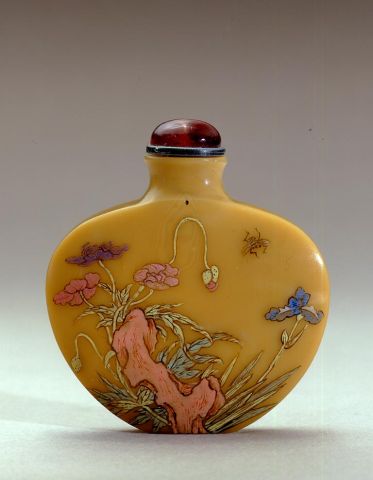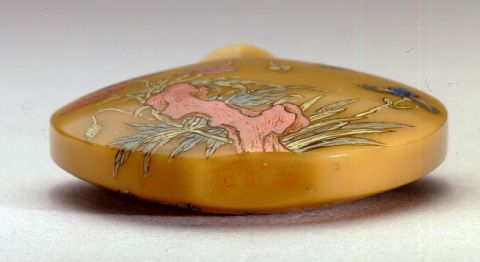


Bottle ID: 00430
YANGZHOU, CARAMEL, INSECT, BUTTERFLIES & GARDEN LANDSCAPE
Date: 1770-1820
Height: 55 mm
Glass, of flattened shield shape, with flattened side panels tapering to an everted mouth at the top and to a slightly concave foot; decorated in famille rose enamels on a caramel colored ground, with on one side a flying insect alighting on flowering plants and grasses which issue from rockwork; the reverse with a pair of butterflies flying above flowering plants; the base with a three character iron-red Guyue Xuan mark.
Attributed to Yangzhou.
Similar Examples:
Crane Collection nos. 204, 240 and 318.
Sotheby's, Olympia, London, June 13, 2003, lot 722, The Arthur Gadsby Collection.
Stevens, Bob C. The Collector's Book of Snuff Bottles, 1976, p. 268, no. 963.
Christie, Manson & Woods, St. James's, London, June 18, 1973, lot 94, The Ko Family Collection, Part II.
Provenance:
Asian Art Studio
Sotheby's, New York, March 22, 2000, lot 166
A Mid-West Collection
Exhibited:
Annual Convention ICSBS Toronto, October 2007
Published:
JICSBS, Winter 2008, p. 12, figs. 16a and 16b
Along with Crane Collection no. 204 and no. 240, this bottle epitomises one of the groups of enameled glass bottles made outside the Palace Workshops, probably from a well-known enameling area such as Yangzhou. This group was usually made of opaque colored glass, a variation from the classic milk-white glass, and often of a form which divides each main fascia of the bottle in two, although the enamel design itself does not demand this. These designs are executed in thin, opaque enamels outlined with a darker line, which was the initial sketch on the body of the bottle upon which the colors were then added. There is little shading, the variation in color tones being achieved by the use of different colored enamels for different parts of the design. In this case, for example, the flowers are of different color pinks and the individual leaves and grass stems are of different colors of green, giving the overall appearance of variation in color.
Interestingly, the colors of the glass bodies of this group have some similarities with the overlay glass colors of the Yangzhou School, especially in the case of this caramel brown color and the opaque turquoise color of Crane Collection no. 240. Despite the fact there is no evidence of a glass-making industry in Yangzhou, there is documentation in the Yangzhou Hua Fang Lu of an enameller Wang Shixing, also known as the "enamel-ware king". This serves to support the notion of a glass-blowing and glass-carving industry in Yangzhou, since the enamellers would have ordered their glass bottles nearby in order to maintain a profitable commercial enterprise.
< Back to full list
 English
English 中文
中文